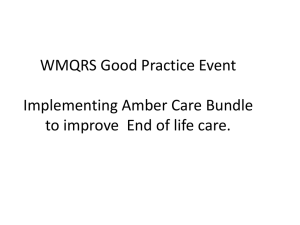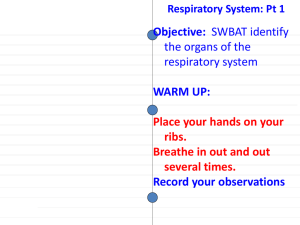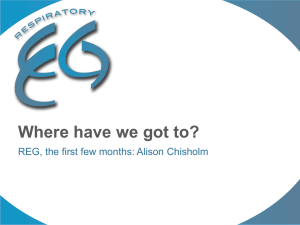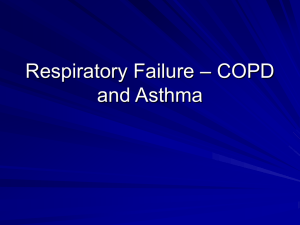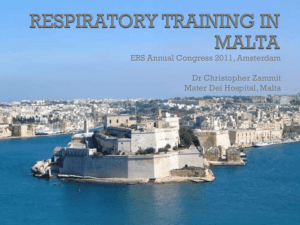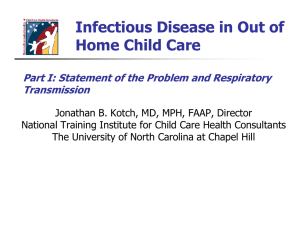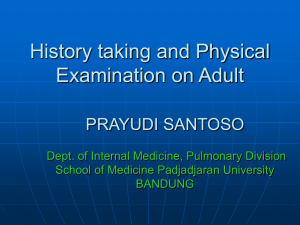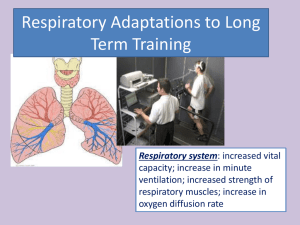Creating a Vision of Care
advertisement
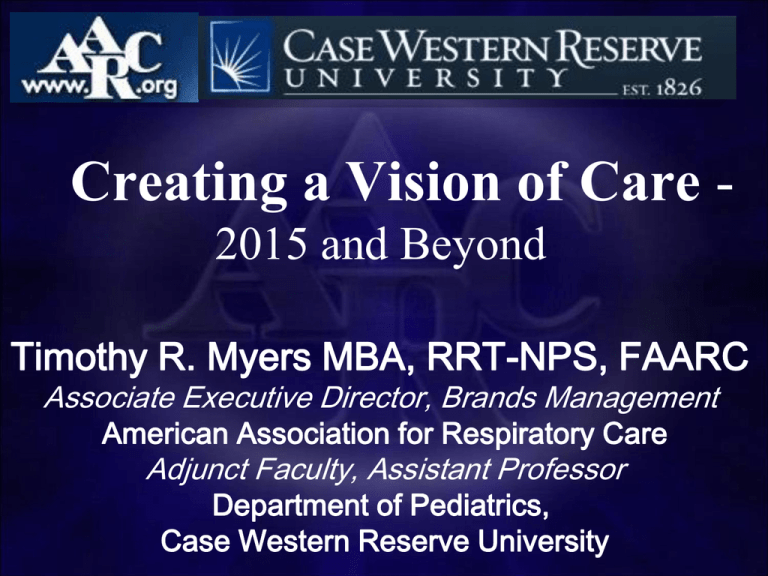
Creating a Vision of Care 2015 and Beyond Timothy R. Myers MBA, RRT-NPS, FAARC Associate Executive Director, Brands Management American Association for Respiratory Care Adjunct Faculty, Assistant Professor Department of Pediatrics, Case Western Reserve University Current Health System Issues • Health costs in US growing faster than: – Employee wages – Economy at large • Preventive services are underused • Low adherence to proven-effective therapies for chronic diseases • Medical errors and safety problems remain too common, accounting for many thousands of deaths and billions of dollars in healthcare costs Property of PPCP: Created by KR 11/24/2010 2 Changes in the Economy How Healthcare Executive Decisions Impact the Workforce • “Perfect Storm” - Economies impact on healthcare • Hospital administrators believe healthcare financing system is broken • Gov’t payments have declined since 2000 • Steps to increase productivity & enhance quality by consolidating staff functions – Case management and disease management – Understanding & implementation of evidencedbased protocols & best practices Four Key Drivers of Healthcare Reform • Decrease cost of healthcare • Improving the quality of care delivered • Evaluating effectiveness using outcome measures • Improving access and resource allocation Future Impact Cut from the Headlines Cut from the Headlines Chronic Medical Conditions Chronic Conditions • 15 most costly medical conditions accounted for ½ of overall growth in health care spending 1987-2000. 1.5 inc Prevalence 3 x the cost Prevalence flat 2 x the cost SOURCE: 1987 National Medical Expenditure Survey (NMES) and 2000 Medical Expenditure Panel Survey, Household Component (MEPS-HC). Chronic Conditions Source: GAO analysis of Medical Expenditure Panel Survey (MEPS) Financial Incentive Worse-case scenario is a 1% Medicare payment reduction across all DRGs in fiscal year 2013, increasing to 2% in 2014 and 3% in 2015. For example, if a hospital’s total inpatient payments from Medicare totaled $50 million in FY 2012, the hospital would lose $500,000 (1% of $50 million) of its inpatient operating payments in FY 2013. Today’s Perspective • In 2013, 150,000 fewer readmissions than Jan 2012 • Reduction in hospital-induced harms credited with saving 15,000 lives and $4 billion • All-cause readmissions rate, according to the report, has declined to 17.5% 1 3 Today’s Perspective • Hospital-acquired conditions declined 9% from 2010 to 2012 – 145 / 1,000 discharges down to 132 /1,000 discharges 1 4 Change in Focus • Hospitals are in a fee-for-service world now where they're rewarded on volume • Next step is how to focus on cost and outcomes under a reimbursement model that doesn't reward volumes. • It has to be about more efficiencies and patientcentered care." IOM Six Aims for Improvement • Patient care that is: • Safe- avoidance of unintended pt. harm • Effective- evidence-based • Patient-centered- focused on needs and rights of the individual patient • Timely- avoidance of delays & barriers to patient care flow • Efficient- elimination of waste • Equitable- fair access to comparable health care services for all IMPLICATIONS FOR HOSPITALS • Achieve solid hospitalphysician (clinical) alignment • Measure, report and deliver superior outcomes • Reduce costs • Form strategic alliances Healthcare Executive Decisions Impact Workforce • A competent RT workforce in 2015 and beyond must focus on: – Improving quality & reducing costs through utilization of evidence-based practice protocols & improving patient movement across the continuum of care • The workforce will soon be asked to assume new responsibilities, and RT graduates will enter a profession with an expanded scope of practice MEDICARE PATIENTS’ USE OF POST-ACUTE SERVICES THROUGHOUT AN “EPISODE OF CARE” (1) Sir Winston Churchill (1874-1965) “ To every person there comes in life that special moment when one is tapped on the shoulder and offered the chance to do a very special thing. What a tragedy if that moment finds you unprepared or unqualified for the work which would be your finest hour." AARC’s 2015 Initiative The Charge • To determine changes required by the profession of respiratory care to meet the evolving demands of the medical community and to position respiratory therapists (RTs) as a vital member of the medical community in the future Questions for Profession • How will patients receive healthcare services in the future? • How will respiratory therapy be provided? • What knowledge, skills, and attributes will RTs need to provide care safely, efficiently, and cost-effectively? • How do we get from the present to the future with minimal impact on the respiratory therapy workforce? Pew Health Professions Commission LINKAGES BETWEEN PRACTICE AND EDUCATION • The respiratory care practitioner of the future will have skills necessary to work in acute, subacute, and long-term care settings. • This means that practitioners will continue to have a firm foundation in the basic sciences and technology, but will also have the critical-thinking skills necessary to use patient-driven protocols. • They will serve as adjuncts to physicians in the management of health care delivery. • They will assume the role of patient educators and care coordinators. • They will play an active role in disease management. • RCPs will effectively follow a patient across the entire spectrum from acute care to subacute care and into home care. RT: “Hybrid” Clinician • Revenue Generators – Have the ability to bill for therapies, interventions and services – Reimbursement: CPT-code based under medical direction – Area specific (i.e Hospitals,Pulmonary Labs, etc…) – Similar to Therapy (Physical, Occupational, etc…) Professions • Service-related – Provide basic care and education to patients with cardiopulmonary diseases – Similar to nursing profession Educating the Future Respiratory Therapist Workforce Competencies Required for Respiratory Therapists Groups of Competencies: 1. Patient Assessment 2. Evidence-Based Medicine and Protocols 3. Disease Management 4. Therapeutics 5. Emergency and Critical Care 6. Diagnostics 7. Leadership Barnes TA et al. Respir Care. 2010 May;55(5):601-16 “Rather than uncoordinated, episodic care, we need to offer care that is well organized, coordinated, integrated, characterized by effective communication, and based on continuous healing relationships” -Eric Larson Predicted Changes in Health Care • Hospitals will provide expensive, episodic care and house cutting-edge life-support technology • Post Acute Care and medical home will continue play an increasing important role – delivery of acute care will move progressively to the patient’s home – Post acute and chronic care will increase in volume and complexity Benefits of RT’s in Skilled Nursing Facilities • Patients had a 3.6 day shorter LOS • Mortality of patients was reduced by 42% • Estimated Medicare cost savings were $97.9 million Muse and Associates. Executive Summary. In: A Comparison of Medicare Nursing Home Residents Who Receives Services from a Respiratory Therapist with Those Who Did Not. Washington DC: Muse and Associates; 1999:1-3 Competency Area II: Disease Management Chronic Disease Management Acute Disease Management Respir Care. 2010 May;55 Respiratory Therapist as Disease Managers Decrease in Hospitalizations and Emergency Room Visits p < 0.001 Decrease in Hospitalizations p < 0.03 Decrease in ED Visits p < 0.001 Rice KB et al. AJRCCM 2010:182 Disease Management Rice KB et al. AJRCCM 2010:182 Competency Area III: Evidence-Based Medicine & Respiratory Care Protocols Evidence-Based Medicine Respiratory Care Protocols Respir Care. 2010 May;55 Changes Expected in Respiratory Care Science of respiratory care will continue to evolve and increase in complexity Clinical decisions will become increasingly data-driven Respiratory care will be an important part of care in all venues Evidence-based algorithms (protocols) will be most common way to deliver respiratory care Greater need for RTs to be involved in research Require RT to be adept at understanding practical ramifications of published research 33 Protocols & Consults • Protocols have been in place in respiratory care since the early 1980’s – Therapeutics, Ventilation • Respiratory Consult Services • Efficient, effective, cost savings • Across the continuum care • Wellness, Prevention and Education “Physician Extender” AARC 2005 Human Resource Survey Physician Extenders We are not alone…… The Future of Nursing • Nurses should practice to the full extent of their education and training. • Nurses should achieve higher levels of education and training through an improved education system that promotes seamless academic progression. • Nurses should be full partners, with physicians and other health care professionals, in redesigning health care in the United States. • Effective workforce planning and policy making require better data collection and an improved information infrastructure. 38 The Future of Nursing: Recommendations • Remove scope-of-practice barriers • Expand opportunities for nurses to lead and diffuse collaborative improvement efforts • Implement nurse residency programs – transition-to-practice program • Increase the proportion of nurses with a baccalaureate degree to 80 percent by 2020 • Double number of nurses with doctorate by 2020 • Ensure that nurses engage in lifelong learning 39 Recognized methods to improve health and reduce costs • Education of patients, professionals, and each other is an essential skill for RTs – important in reducing recidivism in patients with chronic respiratory disease • • • • Protocolized care (best practices) Disease management and self-management Preventive care Risk-factor modulation – Smoking cessation 40 Trends for RT Future? • Job Availability? • Advanced degrees? – Bridge programs / articulation agreements • Focus on Credentials? – Examinations – Licensure Acts • Expansion outside hospital walls • Increased scope of practice Respiratory Care Delivered to Critically Ill Patients by Respiratory Therapists • Critical thinking & communication skills to discuss patient care during rounds and advocate for patient specific, best approach to care are essential • Therapist relied upon as an expert source of information on when and how invasive, non-invasive and high frequency ventilation and the need for ECMO should be applied • Essential care of critically ill patients requires broad knowledge of monitoring approaches • Pharmacology: interaction with mechanical ventilation and to treat cardiovascular dysfunction 42 Areas of Opportunities • Cardiopulmonary Diagnostics • Sleep Medicine • Post-Acute Care – Home, SNFs, LTACs • Pulmonary Rehab • Wellness Programs • Case/Disease Management • Physician Extenders Future Healthcare Trends? • • • • • • Multi-Skilled provider Focus on team and collaboration Consolidation of Acute Care Services Expansion of clinicians into other venues Movement to Wellness/Prevention Further payer penalties Final Thought The road of life twists and turns and no two directions are ever the same. Yet our lessons come from the journey, not the destination. Don Williams, Jr. American Novelist 45

